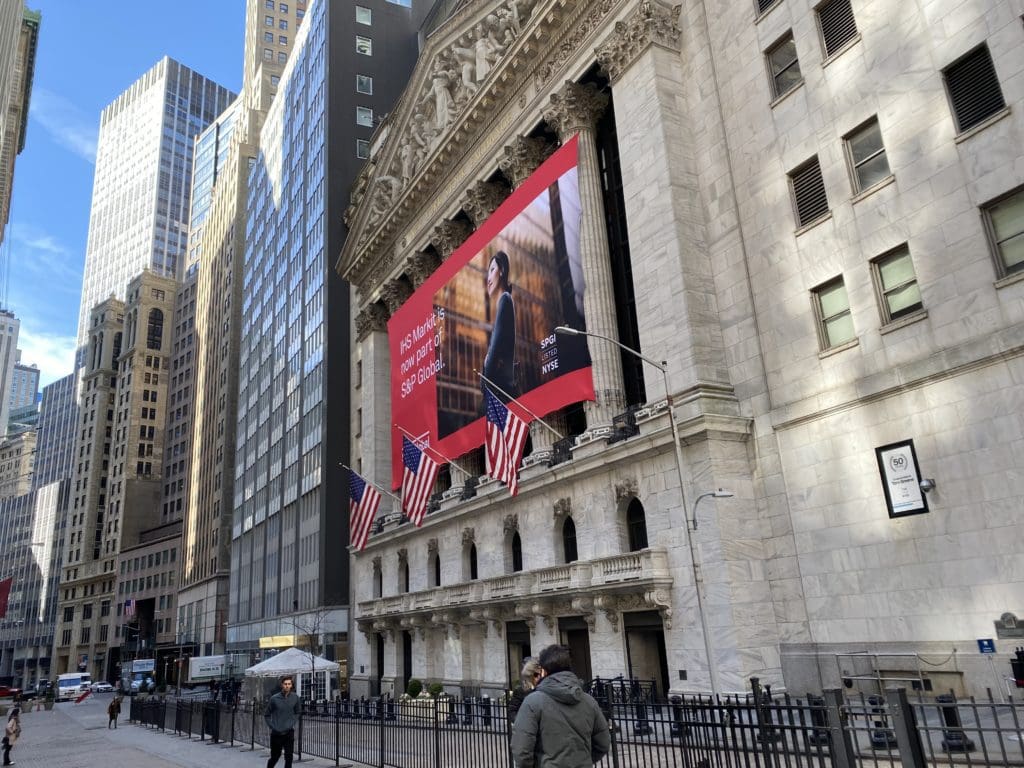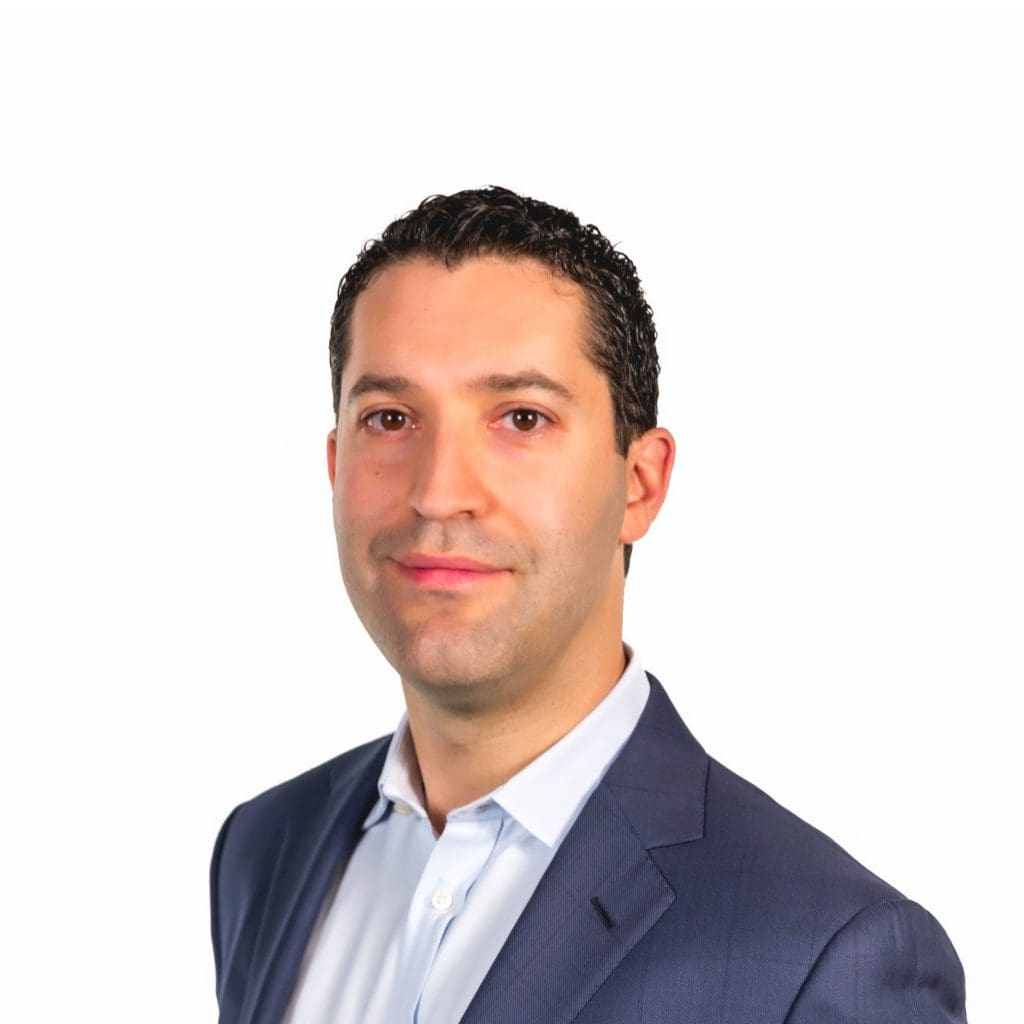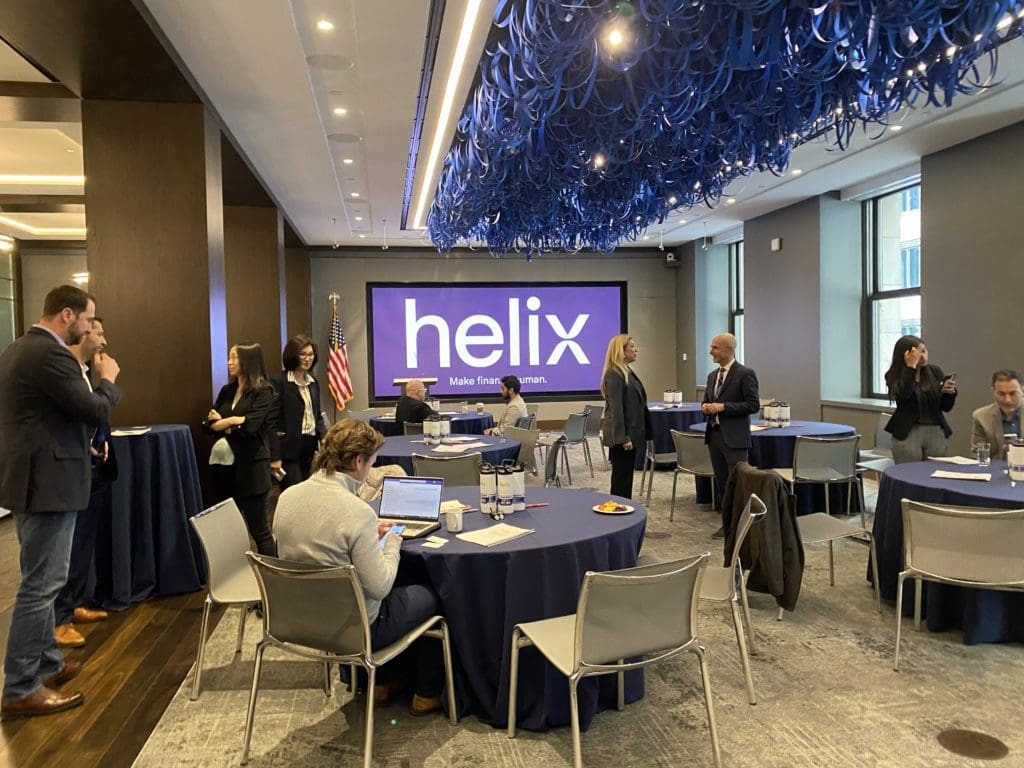Helix, a fintech-focused BAAS by Q2, hosted an unveiling on March 4 for the team at the New York Stock Exchange.
The rebrand was the coming-out party for a fintech onboarding branch under construction for three years that had already built out a suite that reached 11 million consumers through a volume of $20 billion in transactions.
“The idea was that a Helix, Is that framework, the building blocks of life, and it makes up all of us,” Ahon Sarkar, GM of Helix, said. “We wanted to be the Helix of finance, the framework to take accounts, cards, payments, data, controls, and build unique products around people.
Instead, Helix offers an ecosystem of options, all in one place, already in use at big-name fintech platforms, like Acorns or Credit Karma. Sarkar said the team focused on making finance human with a cloud-based core DNA customizable to any consumer-facing fintech.

The problem with banking core
Sarkar said the problem that Helix wanted to address was that there are only two options in banking, checking and premium checking, that’s it. So when Sarkar joined the Q2 Team, he wanted to build a savings product.
But, like so many fintech entrepreneurs, he realized there were no easy ways to onboard new products, even to an existing fintech giant like Q2, thoroughly and efficiently.
“Most banks are built on legacy cores that have been around for a long time. You want product one or product two?” Sarkar said.
Instead, Q2 took on the challenge of building the core infrastructure that it can offer to connect banks, credit unions, and community banks to creators in the fintech world.
They started working on the platform long before the BAAS craze; Sarkar said, back when it was hard to convince firms outside of the financial space that they needed banking products.
Any type of data can build fintech
The world woke up, and brands of all types realized they could leverage any kind of data to offer financial products- even if legacy banks wouldn’t listen.
“As you get to know someone, you learn and understand them. If I noticed that you’ve been getting paychecks for $1,250 every two weeks, I know you as a person, I should be able to raise your limits. You go to the traditional core providers, they’ll be like, ‘That’s not possible,’” Sarkar said. “And the beautiful thing about tech companies like fintechs is that they already had context about you, So they can take that context and build you a product that is more personalized to you.”
What consumer-facing fintechs need, especially young ones Sarkar said, is a unified approach at those customizations, from a brand that has been in financial services for a long enough time to know what they are doing. Helix, through its parent Q2, a fintech building in the space since before the great recession, is that partner Sarkar said.
Helix: Ecosystem within ecosystem

As Jonathon Price, EVP of Merging Business at Q2, would say, the ability to add banking capabilities to any product takes both technology and banking. The ‘tear up the old, build the new’ mantra of tech startups is not the most efficient way. Q2 has been going after a combination of the traditional banks and fintechs to serve institutional consumers.
Price said the four legs of the Q2 firm are biz dev and core dev, M&A and partnerships, Helix, and Q2 Innovation studio.
“A common thread between all four of them, it’s the central constituent that we’re solving for is the fintech or the nonfinancial institution; figuring out how we pair them up with a bank or credit union,” Price said.
“Helix is saying, we have a technology stack, and we have banks, and you need both to embed financial services in your offerings.”
BAAS needs two things
For example, if Acorns, with eight million users, wants to add a savings account option or checking or lending, they need two things: A bank for the charter and compliance and a technology stack. Helix solves for both.
Price said after fighting the ecosystem back in 2018, the firm realized if they built their core stack, they could help partners in a week when it used to take nine months.
“I’ll be honest, if I think going back many years, many other vendors and we were actually part of the problem of why it took so long to get innovation into the banks and credit union hands,” Price said.
“We had the SDK available to our customers back since early ’17. But in 2019 and 2020, we started to realize that we could solve a couple of the key problems the banks and credit unions had by opening that up to the third-party ecosystem and really being a platform. That we use to build our products and ride those rails inside the digital banking channel.”
Innovation studio
Now, Helix offers those rails for a fintech to find its way toward traditional banking infrastructure. In contrast, Q2 Innovation studio does the opposite, as Price explained: help bring community banks to the fintech ecosystem.
An example is a community bank that wants to branch into new products, like lending. Through Q2, solutions can produce a lending product, a crypto savings product, or more, right in the end-users regular bank account. Even if, and especially if, the end-user is a small business owner, why not offer everything they need in one place: a trusted bank account, offering fintech partnered services?
“Let’s bring them back inside the bank or credit union through Q2 Innovation Studio. The average small business in America spends $200,000 a year on 20 separate apps to run the business. We’re saying let’s bring those apps back inside the digital bank ecosystem,” Price said. “So when I’m logged into my app, I can do more than just looking at my accounts and p2p and bill pay. I can now engage in my credit score, and I can engage them into my online lending applications and anything else that is relevant to my financial journey, even if I’m a small business.”
Price said that the official launch of Helix demonstrates years of hard work with dozens of ecosystem partners. The end goal is not to build the next big super app, but to help every enterprise, big or small, to build what financial products they need to reach their customers.
Use case: Crypto benefits at any job
Yan Zhao, President of NYDIG, appeared at the launch to show her support as a Helix partner. NYDIG, renowned for its institutional focus on crypto, built a corporate payment plan through Helix.
The product enables employees to automatically set aside a portion of their paycheck as cryptocurrency, like a retirement savings plan built right into their payment provider.
“NYDIG is a crypto company and a lot of our employees. We’re saying well we would love to get a part of our paycheck in bitcoin, and then you know over the past year or two you see all these celebrities getting paid in bitcoin and so it’s become a big topic,” Zhao said, “And so we really looked into how do we pay our employees in bitcoin and it’s actually illegal in certain states to pay employees using non-dollars, so we can’t do that.”
Integrated solution
Instead, NYDIG worked with Helix to offer an integrated solution that will likely be offered to the 2,100 Q2 employees soon as part of their competitive employment package.
“What we decided to do was make it really easy for employers and employees. So essentially, what happens is the employees open a bank account and an NYDIG crypto wallet with us,” Zhao said.
“The bank account is powered through Helix and our banking partner MVB, and the Bitcoin account is powered by NYDIG. So once they open these two accounts with us, which is a very simple one-step onboarding process, then they can go to their payroll provider and say, ‘Hey, every month, send 5% of my paycheck to this new bank account.’”
That’s it, Zhao said, and the employee has an account that automatically converts cash to bitcoin.
“They can just set it and forget it every month,” Zhao said. “They’ll just go in, and it will happen. But for the employer, there are no regulatory or accounting, or other issues.”
NYDIG aims to ease
The partnership aligns directly with NYDIG’s goal: to make it easier for people to access cryptocurrency by offering it safely through a trusted institutional provider, like a bank or credit union they already work with.
“Being able to offer it through people’s existing trusted financial relationship is both satisfying the regulatory and compliance way, the amount of compliance and diligence and risk assessment that our partners do is tremendous,” Zhou said.
“The other way: We’ve done surveys where a lot of people who already own Bitcoin actually would prefer to hold it through their bank because they just feel safer with it all consolidated.”
Eighty percent of people do not own digital assets, but Zhou said her research has shown that, given a chance, half of that population would own crypto if they could access it through a trusted relationship. NYDIG, with the help of Helix, sees institutional adoption as mass adoption.
Fintech for every brand, not just banks
NYDIG’s project is a fantastic example of Helix energy but still focused on fintech building a fin product for payroll providers and employers.
Paul Walker, SVP, Revenue and Partnerships at Helix, said that fintech is coming to every brand, not just financial brands, and Helix will be there to help.
“When I say traditional brands, I think you’re going to see companies that are leading the tech push of their industries are now trying to add financial products,” Walker said.
“I think you see the market leaders in these industries that are pushing that envelope, but you also see some of the 50-year-old companies that have realized to compete long term, they’ve got to go make these investments and jump in the middle of it.”
Walker even quoted “every company will become a fintech company” from Angela Strange and said companies of all types realize it has gotten a lot easier to get involved in financial services.
Anyone — even just firms that have a credit card on file — can lever that relationship, and they can work in infinitely creative ways, Walker said.
“Everyone has their own unique use case on why they want to go do this, you know, to some, it’s a pure loyalty play, to some be, ‘we want to go serve a market that we feel underserved today through traditional financial services,” Walker said.
“Some of its just stickiness on a data play, and they just know that this is an opportunity to go and get, you know, more and more engagement through these and a revenue source at the end of the day.”
For modern brands, when banking as a service comes into play, Walker said, every firm has a specific strategy in mind and their own datasets they want to leverage. The goal is to get out in front of brands, offering an ecosystem that can help build for any need.
Building for need
That brings it back to what Sarkar said about the philosophy behind building Helix, that the first part was building for fintechs that wanted to create specified financial products. The second part of the problem? The underserved: unbanked people in the world don’t even have the option to use a standard one size fits all bank account. People are left behind, Sarkar said.
“The second part of the problem was, there are tens of millions of people who are underserved by financial institutions. Why is that? Because they don’t have a lot of money, and traditional providers have to charge a lot, so if you’re a bank, you’re going to lose money on someone who doesn’t have a lot of money,” Sarkar said.
“So what happens? Those people don’t get financial services. Those people are cut out of the financial system. And those people get nickel and dimed.”
Nickle and dimed
Sarkar said it costs a lot to be poor. Up to 8% of their income goes toward repaying payday loans for some people because they have no other option.
Sarkar called himself not first-generation, but generation zero: born in India, moved to the U.S. as a kid, to get a job at Bridgewater Associates, one of the largest asset managers on the planet. He said he had seen the spectrum of wealth, and he knows there is a way to build for everyone.
In five to 10 years, Sarkar said he wants to see a word, build a world where there is no such thing as “the underserved.” Everyone deserves a seat at the table.
“It if you focus on the person at the bottom instead of, ‘how do I sign as many clients as possible,’ or, ‘How do I go bring on as many banks as possible?’” Sarkar said. “If you think, ‘how do I solve problems for as many people as possible it is how you change the dynamic.”


Intensely energetic news reporter asking questions covering the collision between Silicon Valley, Wall Street, and everywhere in-between. Studied history at the University of Delaware, learned to write at the Review, and debanked. Email kevin@lendit.com with story ideas, questions, or to say hello.
Credit: Source link





















